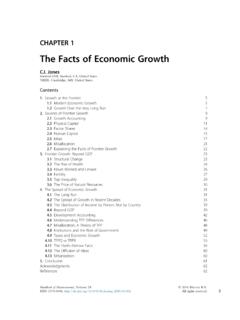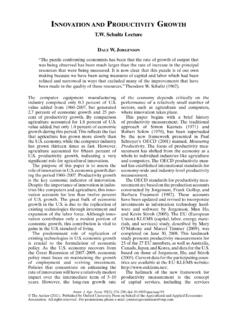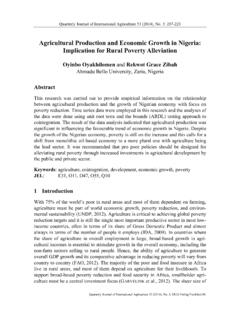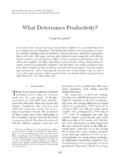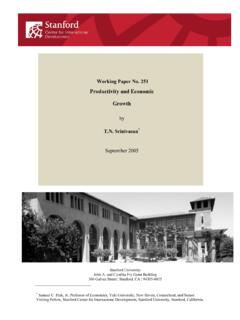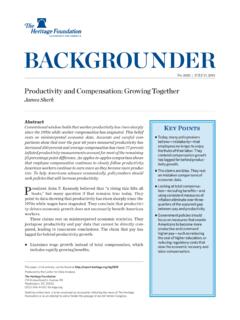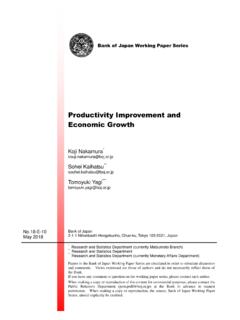Transcription of La bour productivity
1 labour productivity Introduction labour productivity is an important economic indicator that is closely linked to economic growth , competitiveness, and living standards within an economy. labour productivity represents the total volume of output (measured in terms of Gross Domestic Product, GDP) produced per unit of labour (measured in terms of the number of employed persons) during a given time reference period. The indicator allows data users to assess GDP-to- labour input levels and growth rates over time, thus providing general information about the efficiency and quality of human capital in the production process for a given economic and social context, including other complementary inputs and innovations used in production Given its usefulness in conveying valuable information on a country s labour market situation, it was one of the indicators used to measure progress towards the achievement of the Millennium Development Goals (MDGs), under Goal 1 (Eradicate poverty and hunger)
2 , and it was included as one of the indicators proposed to measure progress towards the achievement of the Sustainable Development Goals (SDG), under Goal 8 (Promote sustained, inclusive and sustainable economic growth , full and productive employment and decent work for all).1 ILOSTAT presents ILO estimates and projections on labour productivity , both in constant 2005 US$ and in constant 2011 international $ in Purchasing Power Parity (PPP).2 Concepts and definitions productivity represents the amount of output per unit of input. In ILOSTAT s indicator, output is measured as gross domestic product (GDP) for the aggregate economy expressed at purchasing power parities (PPP) to account for price differences in countries.
3 The GDP represents the monetary value of all goods and services produced within a country over a specified period of time. Employment comprises all persons of working age who during a specified brief period, such as one week or one day, were in the following categories: a) paid employment (whether at work or with a job but not at work); or b) self-employment (whether at work or with an enterprise but not at work). Method of computation The indicator on labour productivity is calculated as follows: labour productivity = GDP at constant prices Number of employed persons 1 Proposed SDG indicator refers to the annual growth rate of real GDP per employed person.
4 For the official list of proposed SDG indicators, see: 2 For further information on ILO estimates and projections of labour market indicators, see : Recommended sources Information on output, measured as GDP, is best derived from a country s national accounts. labour force surveys are typically the preferred source of information on employment (to use in the denominator of the labour productivity indicator). Such surveys can be designed to cover virtually the entire non- institutional population of a given country, all branches of economic activity, all sectors of the economy and all categories of workers, including the self-employed, contributing family workers, casual workers and multiple jobholders.
5 In addition, such surveys generally provide an opportunity for the simultaneous measurement of the employed, the unemployed and persons outside the labour force (and thus, the working-age population) in a coherent framework. Other types of household surveys and population censuses could also be used as sources of employment. The information obtained from such sources may however be less reliable since they do not typically allow for detailed probing on the labour market activities of the respondents. Interpretation and use of the indicator The economic growth in a country can be ascribed either to increased employment or to more effective work by those who are employed.
6 The latter effect can be described through statistics on labour productivity . labour productivity therefore is a key measure of economic performance. The understanding of the driving forces behind it, in particular the accumulation of machinery and equipment, improvements in organization as well as physical and institutional infrastructures, improved health and skills of workers ( human capital ) and the generation of new technology, is important for formulating policies to support economic growth . Such policies may focus on regulations on industries and trade, institutional innovations, government investment programmes in infrastructure as well as human capital, technology or any combination of these.
7 labour productivity estimates can support the formulation of labour market policies and monitor their effects. For example, high labour productivity is often associated with high levels or particular types of human capital indicating priorities for specific education and training policies. Likewise, trends in productivity estimates can be used to understand the effects of wage settlements on rates of inflation or to ensure that such settlements will compensate workers for (part of) realized productivity improvements. Finally, productivity measures can contribute to the understanding of how labour market performance affects living standards. When the intensity of labour utilization (the average number of annual working hours per head of the population) is low, the creation of employment opportunities is an important means of raising per capita income in addition to productivity growth .
8 Limitations National Output measures are obtained from national accounts and represent, as much as possible, GDP at market prices for the aggregate economy. However, despite common principles that are mostly based on the United Nations System of National Accounts, there are still significant problems in international consistency of national accounts estimates, in particular for economies outside the OECD. The factors affecting the comparability of the data across countries include differences in the treatment of output in services sectors, differences in the procedures used to correct output measures for price changes, and differences in the degree of coverage of informal economic activities in developing economies and of the underground economy in developed economies in national accounts.
9 Estimates of employment are, as much as possible, for the average number of persons with one or more paid jobs during the year. In many countries, statistics on the number of self-employed and family workers in agricultural and informal manufacturing activities are less reliable than those for employees. As in the case of output estimates, the employment estimates are sensitive to under-coverage of informal or underground activities, which harbour a substantial part of labour input.










